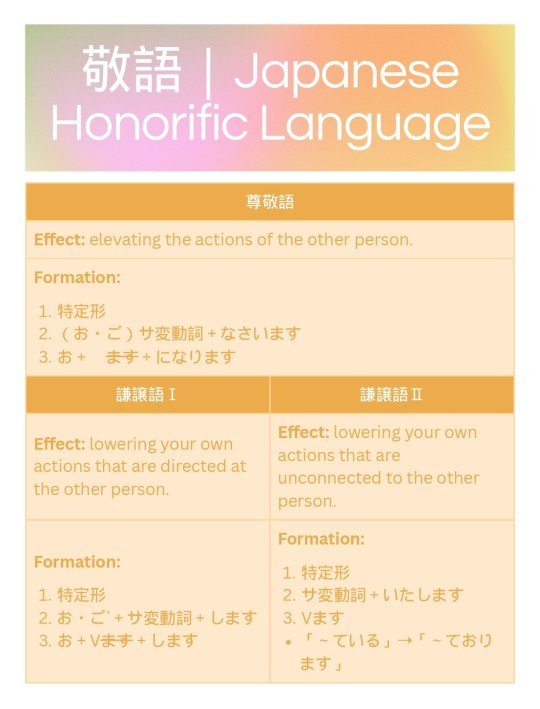#丁寧さ
Explore tagged Tumblr posts
Text
あいさつをしましょう
The following are common polite greetings (あいさつ) and responses. These can be used in work environments and with those above you in social standing.
A: 「ご出身(しゅっしん)はどちらですか。」 「お生(う)まれはどちらですか。」 A: Where are you from? / Where were you born? B: 「イギリス出身です。」 B: I am from England.
A: 「お住(す)まいはどちらですか。」 A: Where do you live? B: 「この近(ちか)くです。」 B: I live near here.
A: 「先日(せんじつ)はありがとうございました。」 A: Thank you for your kindness the other day. B: 「とんでもないです。こちらこそ。」 B: Please do not mention it. It is I who should say so.
A: 「どうぞお上(あ)がりください。」 A: Please come in. B: 「おじゃまします。」 B: Please excuse the intrusion.
「こちらでおかけになってお待(ま)ちください。」 Please have a seat here and wait.
A: 「お茶(ちゃ)をお持(も)ちします。」 A: I will bring some tea. B: 「どうぞおかまいなく。」 B: Please don't go to any trouble over me.
A: 「どうぞお召(め)し上(あ)がりください。」 A: Please go ahead and eat. B: 「では、遠慮(えんりょ)なくいたたきます。」 B: Thank you, I will have some.
A: 「ご無沙汰(ぶさた)しています。お元気(げんき)でいらっしゃいますか。」 A: It's been a long time since we saw each other. Have you been well? B: 「ええ、おかげさまで。」 B: Yes, thanks to you.
A: 「田中さんのご主人(しゅじん)、亡(な)くなったそうですよ。」 A: I have heard that Tanaka-san's husband passed away. B: 「そうですか。お気(き)の毒(どく)に。」 B: Is that right? I am sorry to hear that.
お目(め)にかかるのを楽(たの)しみにしています。 I am looking forward to seeing you. [Note: Used in letters, etc.]
社員: 「お先(さき)に失礼(しつれい)します。」 Employee: I will be leaving first. 部長: 「ご苦労様(くろうさま)。/お疲(つか)れ様(さま)。」 Manager: Thank you for your hard work. [Note: You cannot use the expression ご苦労様 (ごくろうさま) towards your social superiors]
部長: 「お先(さき)に。」 Manager: I'm heading out first. 社員: 「お疲(つか)れ様(さま)でした。」 Employee: You must be tired/Thank you for your hard work.
#日本語#japanese#japanese language#japanese langblr#japanese studyblr#langblr#studyblr#あいさつ#丁寧語#greetings#polite language#polite greetings in japanese#tokidokitokyo#tdtstudy
150 notes
·
View notes
Photo

Children's breakfast prepared by my husband. 10っ分以内で作るパパッと手作り『パパ手作り👨🏻こども朝ごはん定食』 あるものでちょいちょいと作るこどもごはん。 冷蔵庫にあるのでパパッと作ってくれるので、ママも安心。 朝定食はみんな大好きで、子供の成長に合わせて食べる量などもちょっと調整するととても健康的。 成長期は簡単でも栄養はこんな感じでオッケー。 さぁいってらっしゃい。 料理研究家 指宿さゆり ーーーーーーーーーーー #料理研究家指宿さゆり #レシピ開発 #レシピ制作 #レシピ制作専門スタジオ #料理は教養 #食は品性 #オムライス #子供ご飯 #朝食 #目玉焼き #朝定食 #おうち定食 #こどもごはん #レシピ #朝ごはん #洋食 #成長 #丁寧な暮らし #卵料理 #納豆 #お子様定食 #パンケーキ #神戸料理教室 #神戸グルメ #洋食 #インスタグルメ #カフェ飯 #食育 #カフェ部 #朝食モーニング (Kobe, Japan) https://www.instagram.com/p/CpBc_R_ypfl/?igshid=NGJjMDIxMWI=
#料理研究家指宿さゆり#レシピ開発#レシピ制作#レシピ制作専門スタジオ#料理は教養#食は品性#オムライス#子供ご飯#朝食#目玉焼き#朝定食#おうち定食#こどもごはん#レシピ#朝ごはん#洋食#成長#丁寧な暮らし#卵料理#納豆#お子様定食#パンケーキ#神戸料理教室#神戸グルメ#インスタグルメ#カフェ飯#食育#カフェ部#朝食モーニング
8 notes
·
View notes
Photo

(2023/3/29水) 晩メシは… ・とろろ汁 ・インゲンのピーナツあえ ・小松菜の炒め煮 ・「日本一」の青じそつくね串(塩) ・ひじきの煮物 1汁4菜をおかずに、もち玄米ごはんを。 休肝日にしたから、 #丁寧な暮らしおじさん の様相。 とろろ汁、バッチリ美味くできましたー! https://www.instagram.com/p/Cqakb3SSnRW/?igshid=NGJjMDIxMWI=
4 notes
·
View notes
Text

1枚板でダイニングテーブルをDIY。手作りのもので食事を楽しむ









#家具デザイン研究室#diy#DIYMAGAZINE#ダイニング#ととのうさん#手作り#整う#暮らし#生活#リノベーション#セルフリノベーション#古民家#アウトドア#丁寧な暮らし#アート#ルーティーン#家具#整うさんのてづくりぐらし#テーブル##28#ものづくり#整うさん#ライフスタイル#ととのう
0 notes
Text
完成見学会のご案内
これまでの経験の中で一番キツい工程でしたが、やっとのことで完成見学会にこぎつけることが出来ました‼️ お世話になった職人の皆様には本当に感謝感謝です‼️!!
それでは、ご案内です。 開催日:令和6年3月15(金)・16(土)・17(日)・ 23(土)・24(日) 時 間:10時~16時 完全予約制 開催場所:金ヶ崎町 見学申込方法:弊社HPのお問いわせ または 下記電話より ★tel. 0198-41-5615 ★mobile. 090-3755-0155 (申込受付後に詳しい場所をお知らせさせていただきます)


⭐︎『ベースボールハウス』のご紹介 野球が大好きなファミリーが伸び伸び暮らせる家が出来ました。 緑の山々に映える切妻屋根の板貼りの家は、どこか野球(ホームベース)を連想するような外観です。 外装の板材は岩手県産材の杉、内装に使われている床と階段材は岩手県産材の赤松、天井の羽目板は杉と何処にいても木の香りとぬくもりを感じられるお家となりました✨ LDKにはお子さまの背比べを刻んでいく桧の柱が立っています。木の経年変化と共にお子様の成長を暖かく見守ってくれるお家です☺️ 野球少年のお子さまとお父さんが広い庭でキャッチボールをする姿が今から楽しみです‼️😊
UA値0.22W/㎡K Q1.0住宅Level-3 許容応力度計算による耐震等級3 BELS⭐︎5評価取得
#栞家建築舎 #Ume-ie建築設計事務所 #しおりや @tettsu1972 #岩手県産材 #いわて木づかい住宅普及促進事業 #いわて森の棟梁 #いわて木づかいサポーターが作る住宅 #95%が岩手県産材 #板張り外装 #杉板張り #岩手県産赤松フロアー #新住協 #200ミリ断熱の家 #許容応力度計算による耐震等級3 #手仕事 #木の住処 #家づくりは住まいづくり #衣食住を丁寧に #心地よい家 #暖かい家 #エコな暮らし #本と栞と綴り #田舎暮らし #自然素材の家づくり #オガファーザースモール #細部に心を込める大事さ #想いは細部に宿る #中村好文好き #伊礼智好き
#栞家建築舎#Ume-ie建築設計事務所#しおりや#@tettsu1972#岩手県産材#いわて木づかい住宅普及促進事業#いわて森の棟梁#いわて木づかいサポーターが作る住宅#95%が岩手県産材#板張り外装#杉板張り#岩手県産赤松フロアー#新住協#200ミリ断熱の家#許容応力度計算による耐震等級3#手仕事#木の住処#家づくりは住まいづくり#衣食住を丁寧に#心地よい家#暖かい家#エコな暮らし#本と栞と綴り#田舎暮らし#自然素材の家づくり#オガファーザースモール#細部に心を込める大事さ#想いは細部に宿る#中村好文好き#伊礼智好き
1 note
·
View note
Text
【コスチューム】丁寧にセットされた髪
目次 ▼【グラクロ】【コスチューム】丁寧にセットされた髪の基本情報 ▼【グラクロ】【コスチューム】丁寧にセットされた髪のステータス ▼【グラクロ】【コスチューム】丁寧にセットされた髪の着用可能キャラ ▼【グラクロ】【コスチューム】丁寧にセットされた髪の評価 【コスチューム】丁寧にセットされた髪の基本情報 部位 ビューティー レアリティ SR 入手方法 キャラ所持 価格 ― 【コスチューム】丁寧にセットされた髪のステータス HP+530 回復率+2% 【コスチューム】丁寧にセットされた髪の着用可能キャラ 【蒼天の六連星】アーデン 【コスチューム】丁寧にセットされた髪の評価 アーデンの基本コスチューム 蒼天の六連星、アーデンがガチャから排出された際に着用しているもので、いわゆる基本コスチュームと呼ばれるもの。シンプルな髪型のコスチュームなので着せ替えの邪魔をしない。…

View On WordPress
0 notes
Photo

ごま団子ソフト 楊枝のやり場に困りつつ、、 ほんのり塩がオイシィ #お兄さん丁寧すぎて #少し溶けてる、、 #オニヤンマコーヒー https://www.instagram.com/p/CpKHxPeSsxopWLscnJanG0Y3C7mqrcW1kE2NiU0/?igshid=NGJjMDIxMWI=
1 note
·
View note
Text
予定もなく絶好のキメ日和
セフレさん(リバ)に連絡‼︎
すでに遊んでいて、
準備万端です、サプライズ有りと返事あり。
さすが気の合うセフレさん^_^
サプライズって何やろ?と思いながら合流。。
そこには見覚えのある人が、、、
なんと、そこには学生時代にゲイ初体験をした先輩(ウケ)が。。懐かしい気持ち
しかもめっちゃエロい体つきでした笑
セフレさんは僕たちの関係をもちろん知らず
単純にエロいウケを見つけたからガッツリ犯していたらしいw
その後3人でフライト(濃いのを注入)
先輩の手足を椅子に縛り(M字)、
2人共フライトしてもガチガチになるので、見せつけるように絡み合う。
我慢できなくなった先輩の手足を解きベットの真ん中へ、2人のキメチンを丁寧に舐めてる先輩に濃いい我慢汁ダラダラ出す僕とセフレさん。
そうなるとどんどん、先輩がエロくなる。
そんな先輩のケツマンコから昨日出されたであろう、セフレさんのキメ種がww
それを直接舐めるとかなり苦いw
でも美味しいw
僕も種付けしたくなったので、セフレさんの種をローション代わりにしてガン掘り開始。
かれこれ10年ぶりぐらいの先輩マンコは当時の面影も無くトロトロw
最高の具合なので、ある程度掘ってセフレさんと交代しながら2発づつ種付け。
その後色々話したりしてとても満足したエロい日でしたw
187 notes
·
View notes
Quote
教養とは、チンポのようなもの。 身につけ、丁寧に扱い、必要なときにだけ出せば有用に働くが、頼まれもしないのに四六時中曝け出したり、ましてや人に押し付けたりするものではない。
Xユーザーのだいはちくんさん: 「教養とは、チンポのようなもの。 身につけ、丁寧に扱い、必要なときにだけ出せば有用に働くが、頼まれもしないのに四六時中曝け出したり、ましてや人に押し付けたりするものではない。」 / X
323 notes
·
View notes
Text

30 Of My favorites Compliments in Japanese to Praise Artists and Their Work
I love complimenting artists; I like them to know that their work is always amazing, and I enjoy motivating them. Since I started creating pixel art, I have become very close to Japanese artists and realized that it is much easier to compliment them in Japanese, as it seems to make them feel more comfortable! That’s why I put together a list of compliments! Feel free to use them and correct me!
1. 素晴らしい作品ですね。 (Subarashii sakuhin desu ne.)
“It’s a wonderful piece of work.”
2. とても感動しました。 (Totemo kandō shimashita.)
“I was very moved.”
3. あなたの才能に驚かされます。 (Anata no sainō ni odorokasaremasu.)
“I am amazed by your talent.”
4. 色使いが本当に綺麗ですね。 (Irozukai ga hontō ni kirei desu ne.)
“The use of colors is really beautiful.”
5. 細部まで丁寧に描かれていますね。 (Saibu made teinei ni kakareteimasu ne.)
“The details are drawn so carefully.”
6. ユニークなスタイルですね。 (Yunīku na sutairu desu ne.)
“You have a unique style.”
7. 本当に才能がありますね。 (Hontō ni sainō ga arimasu ne.)
“You truly have talent.”
8. 見ていてとても楽しいです。 (Miteite totemo tanoshii desu.)
“It’s very enjoyable to look at.”
9. 構図が素晴らしいです。 (Kōzu ga subarashii desu.)
“The composition is amazing.”
10. こんな作品を作れるなんて信じられません。 (Konna sakuhin o tsukureru nante shinjiraremasen.)
“I can’t believe you can create such a piece.”
11. とても独創的ですね。 (Totemo dokusōteki desu ne.)
“It’s very creative.”
12. あなたの作品はいつもインスピレーションを与えてくれます。 (Anata no sakuhin wa itsumo insupirēshon o ataete kuremasu.)
“Your work always gives me inspiration.”
13. 表現力が豊かですね。 (Hyōgenryoku ga yutaka desu ne.)
“Your expressive power is remarkable.”
14. 見るたびに新しい発見があります。 (Miru tabi ni atarashī hakken ga arimasu.)
“I discover something new every time I look at it.”
15. あなたの作品には心がこもっ���いますね。 (Anata no sakuhin ni wa kokoro ga komotteimasu ne.)
“Your work has so much heart in it.”
16. あなたの作品には魂が宿っています。 (Anata no sakuhin ni wa tamashī ga yadotteimasu.)
“Your artwork has a soul in it.”
17. 発想力がすごいですね。 (Hassōryoku ga sugoi desu ne.)
“Your creativity is amazing.”
18. あなたのスタイルはとても独特です。 (Anata no sutairu wa totemo dokutoku desu.)
“Your style is very distinctive.”
19. 作品に強いメッセージ性を感じます。 (Sakuhin ni tsuyoi messe-ji sei o kanjimasu.)
“I feel a strong message in your work.”
20. この作品を見ると、何かを感じずにはいられません。 (Kono sakuhin o miru to, nanika o kanjizu ni wa iraremasen.)
“I can’t help but feel something when I look at this piece.”
21. あなたの作品を見ていると、とても幸せな気持ちになります。 (Anata no sakuhin o miteiru to, totemo shiawase na kimochi ni narimasu.)
“Looking at your work makes me feel very happy.”
22. どの作品も心に響きます。 (Dono sakuhin mo kokoro ni hibikimasu.)
“Every piece of your work resonates with my heart.”
23. この作品の雰囲気がとても好きです。 (Kono sakuhin no fun’iki ga totemo suki desu.)
“I really like the atmosphere of this piece.”
24. あなたのアートはとても洗練されています。 (Anata no āto wa totemo senren sareteimasu.)
“Your art is very refined.”
25. この作品からインスピレーションをたくさんもらいました。 (Kono sakuhin kara insupirēshon o takusan moraimashita.)
“I received a lot of inspiration from this piece.”
26. あなたの技術は素晴らしいです。 (Anata no gijutsu wa subarashii desu.)
“Your technique is superb.”
27. これからの作品も楽しみにしています。 (Korekara no sakuhin mo tanoshimi ni shiteimasu.)
“I’m looking forward to your future works as well.”
28. 色彩の使い方がとても巧みですね。 (Shikisai no tsukaikata ga totemo takumi desu ne.)
“Your use of colors is very skillful.”
29. こんなに素晴らしい作品を見たことがありません。 (Konna ni subarashii sakuhin o mita koto ga arimasen.)
“I’ve never seen such an amazing piece of work.”
30. あなたの描くキャラクターはとても魅力的です。 (Anata no kaku kyarakutā wa totemo miryokuteki desu.)
“The characters you draw are very captivating.”

Some observations made by my Japanese study friends!

1. あなたの作品には魂が宿っています。
This phrase is correct, but it’s quite poetic. If you want a simpler expression:
あなたの作品には力強さを感じます。 (Anata no sakuhin ni wa chikarazuyosa o kanjimasu.)
“I feel strength in your work.”
2. 発想力がすごいですね。
Correct and commonly used.
3. あなたのスタイルはとても独特です。
Correct, but for a softer tone, you could say:
あなたのスタイルはとても個性的ですね。 (Anata no sutairu wa totemo koseiteki desu ne.)
“Your style is very unique and individual.”
4. 作品に強いメッセージ性を感じます。
Correct, but slightly formal. You could also say:
作品から強いメッセージを感じます。 (Sakuhin kara tsuyoi messe-ji o kanjimasu.)
“I feel a strong message from your work.”
5. この作品を見ると、何かを感じずにはいられません。
This phrase is fine, but can be made simpler:
この作品を見ると、心が動かされます。 (Kono sakuhin o miru to, kokoro ga ugokasaremasu.)
“When I look at this piece, my heart is moved.”
6. あなたの作品を見ていると、とても幸せな気持ちになります。
This is correct and conveys the intended meaning well.
7. どの作品も心に響きます。
Correct and natural.
8. この作品の雰囲気がとても好きです。
Correct and natural.
9. あなたのアートはとても洗練されています。
This is fine, but “アート” (āto) is a bit casual. Using 作品 (sakuhin) might be better for a more formal tone:
あなたの作品はとても洗練されています。
10. この作品からインスピレーションをたくさんもらいました。
This is correct. Another way to say it:
この作品にとても刺激を受けました。 (Kono sakuhin ni totemo shigeki o ukemashita.)
“I was very inspired by this piece.”
11. あなたの技術は素晴らしいです。
Correct and natural.
12. これからの作品も楽しみにしています。
Correct and natural.
13. 色彩の使い方がとても巧みですね。
Correct and suitable.
14. こんなに素晴らしい作品を見たことがありません。
Correct, but sounds slightly dramatic. A softer version:
こんな素敵な作品を見たことがないです。 (Konna sutekina sakuhin o mita koto ga nai desu.)
15. あなたの描くキャラクターはとても魅力的です。
Correct, but can be shortened for a more natural tone:
あなたのキャラクターは魅力的ですね。 (Anata no kyarakutā wa miryokuteki desu ne.)
16. あなたの作品には魂が宿っています。 (Anata no sakuhin ni wa tamashī ga yadotteimasu.)
Correct, but it’s quite poetic and intense. A simpler alternative could be:
あなたの作品には強い感情を感じます。 (Anata no sakuhin ni wa tsuyoi kanjō o kanjimasu.)
“I feel strong emotions in your work.”
17. 発想力がすごいですね。 (Hassōryoku ga sugoi desu ne.)
Correct and natural for complimenting creativity.
18. あなたのスタイルはとても独特です。 (Anata no sutairu wa totemo dokutoku desu.)
Correct, but “独特” (dokutoku) can be interpreted neutrally. For a more positive tone, use:
あなたのスタイルはとても個性的です。 (Anata no sutairu wa totemo koseiteki desu.)
“Your style is very unique and individual.”
19. 作品に強いメッセージ性を感じます。 (Sakuhin ni tsuyoi messe-ji sei o kanjimasu.)
Correct, but it can be simplified:
作品から強いメッセージを感じます。 (Sakuhin kara tsuyoi messe-ji o kanjimasu.)
“I feel a strong message from your work.”
20. この作品を見ると、何かを感じずにはいられません。 (Kono sakuhin o miru to, nanika o kanjizu ni wa iraremasen.)
Correct, but it’s a bit formal and literary. A simpler alternative could be:
この作品を見ると、心が動かされます。 (Kono sakuhin o miru to, kokoro ga ugokasaremasu.)
“When I look at this piece, my heart is moved.”
21. あなたの作品を見ていると、とても幸せな気持ちになります。 (Anata no sakuhin o miteiru to, totemo shiawase na kimochi ni narimasu.)
Correct and natural. No adjustments needed.
22. どの作品も心に響きます。 (Dono sakuhin mo kokoro ni hibikimasu.)
Correct and natural.
23. この作品の雰囲気がとても好きです。 (Kono sakuhin no fun’iki ga totemo suki desu.)
Correct and natural.
24. あなたのアートはとても洗練されています。 (Anata no āto wa totemo senren sareteimasu.)
Correct, but the word “アート” (āto) is a bit casual. Using “作品” (sakuhin) might be more appropriate for a formal tone:
あなたの作品はとても洗練されています。
“Your work is very refined.”
25. この作品からインスピレーションをたくさんもらいました。 (Kono sakuhin kara insupirēshon o takusan moraimashita.)
Correct. Another way to say it:
この作品にとても刺激を受けました。 (Kono sakuhin ni totemo shigeki o ukemashita.)
“I was very inspired by this piece.”
26. あなたの技術は素晴らしいです。 (Anata no gijutsu wa subarashii desu.)
Correct and natural.
27. これからの作品も楽しみにしています。 (Korekara no sakuhin mo tanoshimi ni shiteimasu.)
Correct and natural.
28. 色彩の使い方がとても巧みですね。 (Shikisai no tsukaikata ga totemo takumi desu ne.)
Correct and suitable.
29. こんなに素晴らしい作品を見たことがありません。 (Konna ni subarashii sakuhin o mita koto ga arimasen.)
Correct, but it sounds slightly dramatic. A softer version would be:
こんな素敵な作品を見たことがないです。 (Konna sutekina sakuhin o mita koto ga nai desu.)
“I’ve never seen such a wonderful piece.”
30. あなたの描くキャラクターはとても魅力的です。 (Anata no kaku kyarakutā wa totemo miryokuteki desu.)
Correct, but can be shortened for a more natural tone:
あなたのキャラクターは魅力的ですね。 (Anata no kyarakutā wa miryokuteki desu ne.)
“Your characters are captivating.”

This list was quite a bit of work to make, but it was very fun! I would appreciate it if you shared it! Thank yoooooou!

#jpnotesbyvi#langblr#study blog#studyblr#study motivation#study notes#language#study time#studyspo#study inspiration#study advice#study tips#studies#student#langblog#languages#japanese#learn japanese#japanese language#japanese langblr#japanese phrases#artists on tumblr#artwork#compliment#small artist
286 notes
·
View notes
Text
その日、地下室への階段が現れる。開いたばかりの暗闇へ降りていく。まだ比較的静かだ。
降りたすぐ脇に、トイレがあり、小窓から灯りが漏れている。
その前を通り過ぎると、いくつかの個室が並ぶ。内開きの扉はどれも開いている。通る度に中を覗き、そこの主と視線を交わす。今のところ、ウケばかりやな。そんなことを考えながら、一番奥の個室に辿り着く。空いている。ここにするか……………。
俺は腰を下ろし、上半身を、個室入り口とちょうど反対側の壁にもたせかけて、両膝を軽く立てて足を開く姿勢をとる。当然、少し腰をずらして、雄穴が見えやすいようにする。持ってきたローションを手に取り、熱くなったそこに、自ら指を這わす……………。
その時、トイレの方から、何かを爪で弾くような音が聞こえた気がする。が、すぐにまた静かになるので、空耳だったかな?と思っていると、今度は、明らかに、誰かが咳込んでいる。そして、またシンとする。水を流している。トイレの扉が開く。誰かが出てくる。扉を閉めるのに、そんなに音を立てなくてもよいのに…。
その誰かのガサツな足音が、少しずつこちらに近付いてくる。フラフラになりながら、個室を一つずつ確かめているようだ。自分のドキドキが聞こえる。そして、俺がいる個室の前に現れる!ヤベッ!思わず、その体付きとデカマラにゴクリとする。穴を解す指も大袈裟になる。一歩!その雄が近付く。二歩、三歩。俺のすぐそばまで来ると、一旦、しゃがみ、その指を、俺の穴に添えながら、俺の耳元に顔を寄せ、
「お前、変態だろ…?」
再び立ち上がると、まだ柔らかいそれを、目の前に差し出してくださる。俺は嬉しくなって、恍惚としながら、その先をそっと咥える。舌を使い、首を使い、ゆっくり銜え込んでゆく。あぁ、うっめぇ…たまんね…こんな上玉とヤれるなんて。丹念に気持ちを込めて、丁寧に上下させる。舌を絡ませ、時に喉奥まで誘い込み、ねっとりと快感を与えてゆく。うぉ……あ……おごぉ……うぅ……でけ……うがぁ……
「ゴムは?」
え?ゴム?え?
「俺、ゴムないと…ナマは、なぁ…」
マジ?ここまで挑発しといて…?と責めたい気持ちを抑えつつ、言ってみる。
そうなんすね…………ほんまはナマがいいんで、ゴムはないんすけど……………無理はさせられないっすよね……………そしたら……………挿れなくていいですので、穴に擦り付けてもらうことってできますか?それだけで、俺バリ気持ちいいんすよ☺️
すると、返事をする代わりに、無言で、そのナマデカマラを、俺の穴のあたりに擦り付けてくる。あ……あ…ぁ…気持ち…い…い……た…まん…ね…あぁ…ナマの感触…やべ…ぇ……俺もつい腰を動かして、擦り返してしまう…
そうこうしてる内に、その雄の様子が変わってくる。え?さっきより前傾姿勢になってないか?そんなことしたら、、、、、え、あ、あ、うあ、あ、あぁぁぁぁぁ、デケェ、あぁぁぁぁ、ズルっ、あぁっ!ナマで入っちまったっすよ?
「そんなに欲しけりゃ、〇〇種、くれてやるよ」
うぉぉぉぉぉ!一気に奥までナマデカマラを嵌め込んでくる。かと思うと、一気に引き抜き、すぐにまた根元まで嵌めてくる。大きなストロークだ。少し精子の香りがする。きっともう〇〇種が少しこぼれて、ローションと混ざり合って、いい音を立てている。あ…あ…たまん…ねぇ……気持ちい…い…あぁ…すげぇ…つい俺も、穴をまとわりつかせてしまう。
「おぉ…………っっ!この変態穴、熱くてやべぇな!気持ちいぃっっっ!ほんま淫乱やなぁ、〇〇種、付け甲斐があるぜ!」
さっきのためらい勝ちな様子はどこへやら。ガツガツ味わってくださる。タチ様がよがってくださるのは、ほんまに嬉しい!!
「ほら、ちゃんと孕めよ!イクぞ…おおおおおっ…イクっ…イクイク…イクイクイクイク…………っっっ!!!!!」
あぁっ!何度も何度も、奥の奥に、ナマデカマラが打ち付けられ、一番奥に嵌めたまま、ドクドクと噴き出ている感触がある。あぁっ、幸せだ。俺も穴をギュッと絡めて応える。
嵌めたまま覆いかぶさり、肩で息をしている。ナマしないって言ってませんでしたっけ😁?
「うるせーw」
あ…っ!〇〇種のせいか、もう一段、奥に挿入される。しっかり奥まで擦り込まれているはずなのに、それでもあの香りが漂ってくる。濃い〇〇種だ。すると、余計に興奮してきて、俺も、突然種が上がってきて、思いっきり噴き出してしまう……あぁぁぁぁぁ………っっっっっ!
「こいつマジか!?たまんねぇな、この変態w」
96 notes
·
View notes
Quote
偉くなればなるほど偉そうに振る舞う必要がなくなり他者に丁寧に接する様になるし、賢くなればなるほど自分がいかに何も知らないか気付いて断定口調で話さなくなる。偉そうな奴は実際はたいして偉くない小物だし、断定口調で話す奴は100%ただのアホだ。お前ら、俺の貴重な話が無料で聞けて良かったな!
TestosteroneさんはTwitterを使っています
187 notes
·
View notes
Photo

My father was a good cook and often cooked for me. Children will surely remember such memories. 『パパ👨🏻自家製 豚丼目玉焼き🍳のせこども定食 』 ちゃんと一つ一つが手作りであること。 ちゃんと成長期に合わせて栄養面で配慮されていること。 ちゃんと味覚で楽しめるお料理であること。 ちゃんと多くの料理を楽しめるような美味しいお料理を作ること。 定食仕立てのこども定食は ◉豚丼の目玉焼きのせ🍳こども丼 ◉ベトナムのバーミセリ麺の車麩わかめ仕立てヌードル ◉野菜トマトサラダ ◉納豆汁だく ◉お漬物 こんな感じでお店以上の定食スタイルが嬉しい😊 こどもの頃の記憶は、必ず残っていますのできっと、思い出を振り返るときに嬉しくなるはず。 家庭料理が失われていく現在。家庭料理自体が遠い存在でもある日本の家々。 だけど、美味しいものは食べたいと、日々テレビや雑誌やネットサイトでもアニメでもドラマでも『グルメグルメ』です。 でもそんな美味しいものを健康に楽しめる家庭は、周りから見てもほっこりするものです。 女性だから男性だからと家庭料理ができないなんてありませんので、料理を楽しめる人は幸福度指数が高くて当たり前かもしれません。 成長期に栄養が行き届かない現代家庭が多く、糖質と脂質で必須ビタミンなどが不足しています。 身体ってそれぐらい差が出るので、ぜひ美味しい健康を家族みんなで楽しんで! こどものグルメ(孤独のグルメ)で楽しみましょう(笑) 料理研究家 指宿さゆり ーーーーーーーーーーー #料理研究家指宿さゆり #レシピ開発 #レシピ制作 #レシピ制作専門スタジオ #料理は教養 #食は品性 #丼物 #子供ご飯 #昼ごはん #子育てグラム #朝定食 #おうち定食 #こどもごはん #孤独のグルメ #赤だし #こどものグルメ #成長 #丁寧な暮らし #今日のランチ #夫の手料理 #お子様定食 #目玉焼き #神戸料理教室 #神戸グルメ #町食堂 #インスタグルメ #食堂 #食育 #お昼ごはん #豚丼 (Kobe, Japan) https://www.instagram.com/p/CpJoWmmS5jM/?igshid=NGJjMDIxMWI=
#料理研究家指宿さゆり#レシピ開発#レシピ制作#レシピ制作専門スタジオ#料理は教養#食は品性#丼物#子供ご飯#昼ごはん#子育てグラム#朝定食#おうち定食#こどもごはん#孤独のグルメ#赤だし#こどものグルメ#成長#丁寧な暮らし#今日のランチ#夫の手料理#お子様定食#目玉焼き#神戸料理教室#神戸グルメ#町食堂#インスタグルメ#食堂#食育#お昼ごはん#豚丼
0 notes
Quote
私自身も、かれこれ40年前の学生時代、身に覚えのない冤罪で、逮捕は免れたが、任意で呼び出された八王子警察署で、懇切丁寧な指紋採取の直後、突然、態度が豹変し、「犯人はお前しかいない!」と机を叩き、酷く恫喝され(昔の刑事ドラマとほぼ一緒)、決めつけたら最後、こちらがどう、何を説明しようが、全く聞く耳を持たず、40年後の今もトラウマとして深く心に刻まれている。この時感じたのは、人間、狭い空間で、言い分を聞き入れな��高圧的な支配下に置かれると、強気な相手に飲まれるというのか、埒があかず、なぜか諦めムードになって、ついつい相手(警察)の言い分に屈してしまうという、普通では、あり得ない感情に陥るということだ。任意であってもこの場から逃れたいという心理が働く。この警察官は「任意なので自発的に話せるように取り調べた」とあるが、これは嘘、あり得ない。体験した者でないと理解しがたいだろうがここに断言しておく。
“冤罪”で12年間服役 看護助手にうその自白させた警察官 自身の正当性を主張 大津地裁(関西テレビ)のコメント一覧 - Yahoo!ニュース
172 notes
·
View notes
Text
敬語の5分類|The 5 Types of keigo
In the Japanese language it is possible to show respect towards another person by replacing words, mostly verbs, with politer equivalents. This can be done by using elevating expressions for the actions of your superior or degrading expressions for your own actions.

Overview: Verb Formation Rules for sonkeigo 尊敬語, kenjōgo I 謙譲語Ⅰ and kenjōgo II 謙譲語Ⅱ (also known as teichōgo 丁重語).
In a guideline released by the Japanese Agency for Cultural Affairs in the year 2007 keigo has been divided into five types: 尊敬語・謙譲語Ⅰ・謙譲語Ⅱ(丁重語)・丁寧語・美化語. The first three types demonstrate the most complex rules, hence why I summarized them in the chart above for a quick overview. Hereafter, you can find thorough introductions to each type.
尊敬語|Respectful Language
Sonkeigo is the most basic method to pay special respect towards a teacher, a superior or a client. This can be done by switching the verb (refering to the action of your superior) with its passive form.
e.g. 読みます → 読まれます
However, the degree of politeness isn't that high. Hence, it is important to learn the following formation rules as well:
1)特定形 |Special forms
Some verbs have a fixed forms. If a verb has a special form it is to be used.¹
e.g. いる・行く・来る → いらっしゃいます
2)サ変動詞+なさいます
In this context サ変動詞 refers to nominal verbs. Basically, nouns that can be turned into verbs by adding する. It is possible to add お or ご infront of the verb but it can be also omitted if unsure which prefix is the right one.
e.g. 出発する → (ご)出発なさいます
3)お+Ⅴます+になります
This formation rule is for all verbs that do not belong into either of the two categories above. Omitting ます leaves the so-called renyōkei 連用形 or conjunctive form of the verb. Here, the prefix added is always お.
e.g. 待ちます → お待ちになります
It is not uncommon to apply this formation rule to サ変動詞 as well. Depending on the nominal verb お needs to be changed to ご.
e.g. 参加する → ご参加になります
However, there are exceptions. Some nominal verbs are not idiomatic and end up sounding unnatural to native ears.
e.g. 運転する → ご運転になります ✕ 運転する → 運転なさいます 〇
謙譲語 Ⅰ|Humble Language I
Kenjōgo I + II have the opposite effect of sonkeigo. They degrade one's status and are therefore applied only to your own actions or the actions of someone from your inner circle (e.g. a co-worker, or a family member).
In contrast to kenjōgo II, kenjōgo I is used when your action (or the action of someone from your circle) is directed at the person you want to pay respect to. It is also used when you do something for said person.
The formation rules are as listed below:
1)特定形 |Special forms
Some verbs have a fixed forms. If a verb has a special form it is to be used.¹
e.g. 言う → 申し上げます
The translation would be "saying sth. to sb." or "telling sb. sth." implying that your action is directed at the person you want to pay respect to.
2)お・ご+サ変動詞+します
Again, there are some verbs that sound unnatural when this formation is applied.
e.g. ご運転��ます ✕
In this case, you can formulate the sentence with ~させていただきます or switch to kenjōgo II.
e.g. 運転させていただきます 〇 運転いたします 〇
Note that, depending on the situation ~させていただきます might give of the impression that you are putting yourself down too much. This can result in making your counterpart feel uncomfortable.
3)お+Ⅴます+します
This formation rule is for all verbs that do not belong into either of the two categories above. Omitting ます leaves the so-called renyōkei 連用形 or conjunctive form of the verb. Here, the prefix added is always お.
e.g. 伝える → お伝えします
謙譲語 Ⅱ|Humble Language II
Kenjōgo II is used when your own action is unconnected to the person you want to pay respect to. Therefore, this type of language can often be found in anouncements, news reports or broadcasts elevating its audience. At train stations one often repeated phrase is:
e.g. もうすぐ電車が来る → まもなく電車が参ります
In the example above you can see that not only the verb has been switched with a politer equivalent, but the adverb as well. There are many words that can be switched with politer versions. Unlike verbs, they do not need to be inflected and can be studied like regular vocabulary.
It can also be pointed out that the action does not have to be conducted by the speaker, but can be an object (like in the example above) or a third party as well.
The formation rules are:
1)特定形
Some verbs have a fixed forms. If a verb has a special form it is to be used.¹
e.g. 言う → 申します (as in 私は◯◯と申します)
When introducing yourself you simly "say" or "state" your name. This is not considered an action that is directed at the person you want to pay respect to, hence it falls into the category of kenjōgo II.
2)サ変動詞+いたします
e.g. 応募する → 応募いたします
3)丁寧語
For all verbs that do not fall under the categories above, teineigo is used, or in other words the です・ます form.
e.g. 話す → 話します
In case the ~ている form is used, the degree of politeness can be elevated by replacing it with ~ております which is the special form of いる.
丁寧語|Polite Language
Teineigo is the neutral polite language. You're probably already familiar with this one, since this is the most foolproof way of speaking politely due to its absence of any kind of seesaw principle. It is used everywhere outside of your circle of friends and the safest way to talk to strangers. However, in certain situations it is expected to raise the level of politeness.
e.g. 聞く → 聞きます
美化語|Refined Language
There is a certain number of words, especially nouns, that can be turned into more elegant sounding versions. It can be easily understood by just looking at some examples.
e.g. 金 → お金 酒 → お酒 料理 → ご料理 米 → お米 散歩 → お散歩
Adding the respective prefix お or ご takes away the roughness of a word. This, however, can only be done with a few selected words. Refined words are commonly used in both formal and informal speech.
‾‾‾‾‾‾‾‾‾‾‾‾‾‾‾‾‾‾‾‾‾‾‾‾‾‾‾‾‾‾‾‾‾‾‾‾‾‾‾‾‾‾‾‾‾‾
¹ I compiled all special forms 特定形 that you need to know in this post: 敬語の特定形|Keigo: Special Verb Forms.
#文法#敬語#japanese langblr#langblr#studyblr#study movitation#learning japanese#japanese vocabulary#study aesthetic#light academia#japan#japanese#study blog#study notes#language blog#language#lingusitics#keigo#study motivation#studyspo#japanese studyblr#japanese grammar#japanese language#japanese studyspo#日本語#日本語の勉強#nihongo#learn japanese
253 notes
·
View notes
Text
高校生だっただろうか、もしかしたら中学生だったかもしれない。初めてネット上で見ず知らずの人とメールアドレスを交換した。確か2つ3つ上の男の人で、最初はお互いの歳も知らなかった。インターネット上で人と連絡先を交換すること、やりとりすることはダメだと義務教育で習っていた。交換する時、初めて規律を破ることに後ろめたさや罪悪感、少しの怖さを感じていた。けれど、彼の人となりを知って、私たちはお互いのことを打ち明けるような仲になった。呼び方もお互い使っていたメールアドレスから“ひかる先輩”、“はるちゃん”と呼び合っていて、個人情報は住んでいる都道府県と歳しかしらなかった。今はどちらもちゃんと思い出せない。
掲示板で彼の元カノとよりを戻したいという相談に乗ったことが始まりだった。メールのやり取りも恋愛や学校のことばかりだった。内気なんだけれども内省できる人で、少しずつ自分を変えようとしていて、「明るくなったね」と人に言われるようになって、その元カノからも「良いふうに変わったね」と言われて喜んでいた気がする。自分の話もした気がするけれど、内容はもう思い出せない。あの時は誰のことが好きだったんだっけ。少し経ったくらいからスマホが普及して、メールの頻度がどんどん減った。ラインやインスタといったSNSを利用するようになった。パソコンのメールなんて確認しなくなった。
最初から最後まで会いたいと言うこともなかったし、会いたいと言われることもなかった。最近、またふと思い出して、自分の使っていたメールアドレスも思い出した。Yahooメールをログインしようとしたら、長期間ログインしていなかったことでアカウントが運営に削除されていた。なんて勝手な。最後になったメールがどんな内容だったのか思い出せないし、彼を調べる道も途絶えてしまった。今まで誰にも彼のことを話さなかった。話す必要もなかった。私と彼との間には何も起きなかったし、書き留める必要もなかった。だけど、たまに思い出す彼のことを初めてここで打ち明ける。
今はもう30代?どこで、なにを、誰といるのだろうと数秒仄かに思ってまた記憶がどこかへ行く。もう2度と会えないような気がする。いや、そもそも会ったことなんてなかった。いつかのやりとりが永遠の別れだと気づくのに、随分と時間がかかってしまった。そんな別れ方を人生で幾度となく経験して来た。どんなに人との関係を凝視していても、これからもこんな別れは増えていくのだろう。最後だとわかっていれば、もっと丁寧に別れられただろうに。むしろ、最後だとわかっていれば別れなかったかもしれない。今となっては、もうなにも掴めない。でも確実に、わたしの人生にいた人。
135 notes
·
View notes